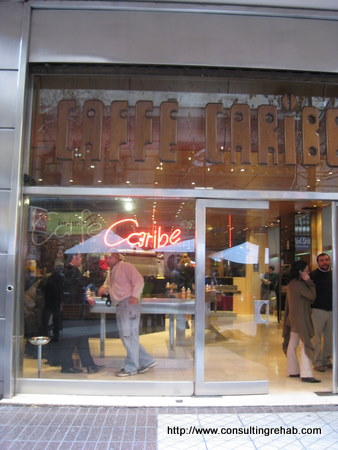Buckle up, this one is going to be interesting…
Cafe con piernas: The background
So I was in Santiago for a few days back in 2002 and I vaguely remember going on a city tour with a tour guide that told us that there are topless coffee shops here–e.g., coffee shops in which the women serving the coffee are topless. After telling us this he kind of laughed, so I laughed and assumed he was either making it up or that there was like one shop in the entire city and it was a complete oddity similar to this one in Maine (which sadly burnt down a few months after opening). I was wrong.
What we’ve learned over the past week or so is that this is actually a bit of a cultural phenomenon here in Chile and has been for almost 50 years. It’s called ‘cafe con piernas’ which means ‘coffee with legs’ and does not refer to an extra caffeine boost. It started with a place called Haiti (which still has many locations around downtown). At the time, the downtown area was full of almost entirely men coming to work (apparently the women usually stayed home) and the idea was to provide them some entertainment during the work day. So, Haiti opened some coffee bars and had the women wear provocative clothing. Unsurprisingly, this worked out pretty well and more and more similar shops kept opening.
In the mid/late 90s another coffee shop decided to differentiate itself by featuring what they called the “Millionaire Minute” which was a 60-second period during which all of the women would fully remove their tops. Again, unsurprisingly, this innovation was largely well received by the clientele and was the catalyst for a whole new level of cafe con piernas experiences. As you will see in a few paragraphs, I do not use the phrase ‘a whole new level’ lightly…
Cafe con piernas: The news report/video
I think that before I give you the details of our personal experience with cafe con piernas….
…
…
(sorry, just had a flashback)
Right, before I give you the details of our personal experience with cafe con piernas, it might be best if you watched the following video about it produced by a news agency in London in 2007 (it was aired on network TV, so should be safe for work):
Cafe con piernas news report (sadly, they have disabled embedding, so you will have to watch it on YouTube)
Ok, can’t put it off any longer. On to our personal experiences…
The misadventures of Ryan and Jen – Chapter 1: The beginning
As we were exploring our new neighborhood over the last week, we noticed a very large number storefronts with big signs stating that they were ‘cafes.’ We were like, “Jackpot, so many cool looking places to get coffee!” As we continued to explore, we noticed that many of them had either blacked out or, more commonly, mirrored windows (meaning, the kind that you only see your reflection if you try to look in)–this seemed odd…

Looks pretty normal... except for the mirrored glass and the small sign that says "se necesita señorita" which other than being a neat rhyme, means something like "we need chicks" (all of them have this sign, which for awhile seemed like a solid job prospect for Jen...)
Later, we were walking around downtown and ran into a couple of other coffee shops called Haiti (the aforementioned original cafe con piernas institution) and Caribe. These have normal windows and are usually pretty crowded.

Looks perfectly normal from the outside
Unfortunately, this picture doesn’t capture it, but you can usually see the serving women from the street and they are all wearing very short, very tight dresses. Also, the area behind the coffee bar is raised up about a foot in order to maximize the view. Seeing this triggered the memory of the ‘topless coffee bar’ comment from the tour guide during my first trip here back in 2002, so we started doing some Google research and began to learn all about cafe con piernas (including the video above and some links below).
Upon reading about these shops, you may be surprised to hear (I certainly was) how excited my lovely wife Jen became about investigating them first-hand. After watching the video, she was all excited to go check one out first thing the next morning, saying it was “a cultural experience”. If you haven’t yet watched the video (seriously, watch it) an important and likely somewhat obvious fact to know is that the shops with mirrored glass are a bit more… shall we say, progressive than Haiti and Caribe–these two are considered to be the tamest of them. Another fact you should know before I proceed is that all of these shops offer standing room only–no chairs, you drink your coffee while standing at the bar.
I suggested that we go to one of the tame ones, but Jen was having none of that. Here is a direct quote from her: “if I’m going to have to stand up to drink my coffee, I better get some ‘boob-age’.” Seriously, that’s what she said. There were other choice quotes from her as well, but I’ll save them for later; suffice to say, she was very excited–even more so than usual. I think that now, in retrospect, she deeply, deeply regrets taking this stance…
The misadventures of Ryan and Jen – Chapter 2: First attempt
There are literally 5-10 of the mirrored glass-type establishments within a few blocks of our apartment (I told you it was a good neighborhood!), and given that you can’t see inside, we weren’t sure how to go about choosing one. Luckily, my Harvard-educated wife concocted a plan; the plan was to loiter across the street from a few of them and choose the one had the most in/out traffic (we certainly did not want to be the only ones in there). It was a reasonable plan, but as we were camped out across the street from a few trying to look inconspicuous, Jen’s excitement turned into nervousness that she would be rejected because she is female. Then after 5 minutes of not seeing anyone go in or out, the nervousness escalated. We decided that we would wait until we talked to some locals and got some advice on where to go. If one wanted to say this in another way, one would say that we chickened out.
That afternoon we went on a bicycle tour of the city (which was cool), and Jen excitedly asked our guide about cafe con piernas. Understandably, he laughed. Then, he explained that there are PG, R and X rated ones and that if we wanted to learn more about them (including how to tell which was which), we should go on one of their other tours–seriously, this is a big enough thing here that it is included in city tour itineraries. He explained that here in Santiago it is often somewhat cold, so everyone wears layers and is completely covered up most of the time; in his opinion, the girls in cafe con piernas venues are merely wearing the sorts of things that women might wear on the street in a place like Rio de Janiero and that it is very popular here because it’s so rarely seen. Makes sense. The other thing he told us was that it should be completely fine for her to go into them–I later learned that that was all she needed to hear…
The misadventures of Ryan and Jen – Chapter 3: Oops!
The following day I assumed that Jen’s excitement would have blown over. Again, I was wrong. We got out of bed and she was almost jumping up and down when she said, “Wanna go get some coffee???” I said, “Really? Still?”
Her: “Yes! He said I could go!!”
Me: “Ok…”
We decided to attempt the same plan. We first camped outside of this fine looking venue for ~5 minutes:

We couldn't tell for sure what those pictures were on either end of the sign, but we were pretty sure this place was classy
We saw one person go in, but in general we didn’t love the vibe, so we ultimately decided to keep walking. About a block away we encountered this place:

We have a winner
We stood outside, casing the place, for 5 minutes or so while I repeatedly asked Jen if she was sure she wanted to do this and she repeatedly answered in the affirmative. Eventually we saw a few men go in so we sucked it up and went for it.
Oh boy.
Seriously, this is challenging to write. Taking pictures was the furthest thing from our mind (and likely would have resulted in us being beaten out back by a guy named whatever the Chilean equivalent of Biff is), so I’ll do my best to detail the experience in words (which will force me to relive this highly traumatic experience quite vividly–hope you appreciate this!)
The room was about the size of a bedroom. The coffee machines/baristas were off in the back. There was a narrow standing bar in the middle and then a counter along the walls where you could put your coffee; otherwise, wide open space. There was fairly loud techno music playing and it was dark-ish, but certainly light enough to see the staff… Also, all of the walls were mirrored (and possibly the floor/ceiling too, though I don’t remember). Equally weird was how easy it was to see out the front windows to the people on the street.
We were immediately greeted by a woman wearing the standardized uniform–5 inch heels, g-string/thong and very revealing bra; that’s all. She kissed us both on the cheek somewhat provocatively and then asked what we would like. She did not seem at all disturbed by Jen’s presence–nor did the other patrons despite what they were doing. We ordered 2 coffees. She told us that it would cost 2,000 pesos so I gave her 2,000 (this is more or less the normal price for coffee). Then she asked if we might want to give her a little something extra for her. Jen gave her another 2,000.
She went off to retrieve our coffee and we nervously looked around–which was pretty easy given all of the mirrors and the fact that we had situated ourselves at the stand-up bar in the middle. This few minutes that we had to ourselves taking in the scenery and wondering what would happen to us when she returned with our coffee was a special time for us. It probably always will be. Whether we want it to be or not.
At the time we were there (~11am) the staff consisted of ~5 girls all dressed the same and there were maybe 3 male customers–each there on their own, and each ‘enjoying’ his time with one of the staff. We had read a few accounts of other experiences at such places and had heard of one which said that the girls were unattractive, overweight and groped the customers left and right. We heard another account in which the people said that the girls were very attractive but seemed completely disinterested in the customers. In the 2 by 2 of x-rated cafe con piernas venues, Cafe Rio is definitely in the “winning” quadrant–very attractive girls, lots and lots of groping.

Note: Consulting Rehab does not necessarily condone or endorse the views of this 2by2
In fact, the word ‘groping’ really doesn’t describe the kinds of things that we saw reflected in the mirrors. The other girls were definitely ‘dancing’ with the other customers–keep in mind, there are no chairs, so it was sort of a standing lap dance. Some of the customers definitely had their hands all over (and under) the skimpy outfits of their dedicated girl. And, we also saw one girl kneeling down in front of a guy for a couple of minutes appearing to provide a special service. Truly, experiencing things like this with your wife is the bedrock of a strong marriage.
Soon, our señorita came back with our coffee and stood about 2 inches away from Jen, making it clear that she would be our companion until we left. I’m not a religious person, but I have thanked god more than once in the last couple of days that she chose to stand next to Jen and not me. Not really having a roadmap for situations like this, Jen struck up a conversation with her. We learned that she moved here 2 years ago from Peru and her 6-year-old son lives back in Peru with her mother. She’s worked at the bar the whole time and makes money to send home and to be able to go visit. She also told us that the most crowded time of day was at 1pm, right around lunch break (keep in mind, these places are closed at night and don’t serve alcohol). It was actually a very nice conversation and we would have truly enjoyed getting to know her if not for the dry humping (and more) happening a few feet away.
I don’t think I’ve ever drunk a coffee so quickly. We were out within 10 minutes. Jen was no longer excited. We’re pretty sure we had stumbled into one of the hardest core ones based on what we’ve read and it felt more like being in a brothel or extremely hands-on strip club than a coffee shop. Suffice to say that we were a bit messed up for the next few hours.

2 hours later we walked by again to get a picture of the front -- Jen's face looked like this for most of the day
It was about 1pm when we walked by the second time and we saw 7+ men walk in within 2 minutes… curious how it works when the clients outnumber the staff… not curious enough to go back. Interestingly, there definitely does not seem to be any sort of social stigma associated with walking in and out of these places… many of them are on busy pedestrian streets and we’ve seen people coming in and out of them quite a bit.
After this experience, despite our need to find an income, we decided that it was no longer a viable option for Jen to become one of the señoritas that they necesita.
The misadventures of Ryan and Jen – Chapter 4: Our tamer experience at Cafe Caribe
Because we had already done the hard part and gone into a hardcore one, we decided to try one of the tamer ones the next day to complete our research. It was a world of difference. There were men there, but also women and while the servers were definitely wearing tight dresses, it wasn’t that big of a deal.

I fake tried to take a picture of Jen to get one of the staff, but she was wise to us and mostly escaped. There are better pictures in the links below
This was basically just a normal coffee shop. In fact, I’d argue that the fact that you had to stand up to drink your coffee was weirder than the outfits the staff were wearing. This was actually kind of a fun and different cultural experience–night and day from our Cafe Rio experience.
The misadventures of Ryan and Jen – Epilogue
It’s been a few days now and we’ve mostly recovered from our experience, but as I said, our 10 minutes in Cafe Rio will always be a special time for us. Writing this has been cathartic. Let us never speak of it again.
Cafe con piernas: Our advice
If you are a tourist here in Santiago and want to be able to say you went to cafe con piernas (and it is worth checking out), go to Cafe Caribe or Haiti. If you are looking for a coffee and some dry humping (or more, did I mention there was a staircase in the back that likely lead to someplace a little quieter…), try Cafe Rio. Beware of the other mirrored glass establishments, you certainly wouldn’t want to end up in the unattractive/aggressive groping quadrant of the cafe con piernas 2 by 2.
Cafe con piernas: Other interesting links
![]()





































